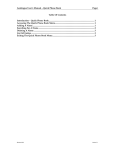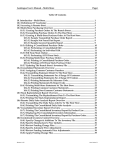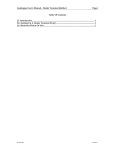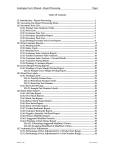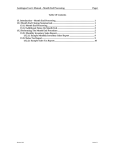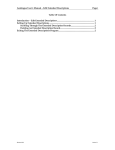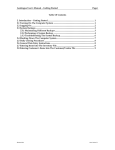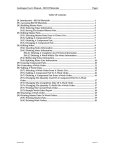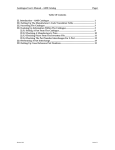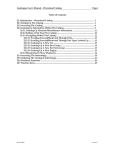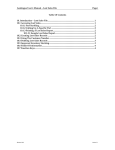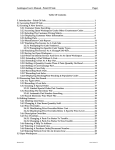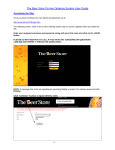Download Autologue User`s Manual – Product Line Update Page i Table Of
Transcript
Autologue User’s Manual – Product Line Update Page i Table Of Contents 9. Introduction – Product Line Update ................................................................................ 1 9.1 Accessing/Viewing A Product Line Record.................................................................. 1 9.2 Viewing A Product Line’s Sales History....................................................................... 2 9.2.1 Modifying A Product Line’s Sales History ......................................................... 4 9.3 Modifying A Product Line Record ................................................................................. 4 9.4 Fields Of Information....................................................................................................... 4 9.5 Vendor Net Percent ........................................................................................................... 5 9.6 Popularity Pricing.............................................................................................................. 5 9.7 Customer Sales History Levels ....................................................................................... 6 9.8 Increasing Sales, Profit And Inventory Turns ............................................................. 6 9.9 Function Keys..................................................................................................................... 7 Revision 3/02 Version 7.1 Autologue User’s Manual – Product Line Update Page 1 9. Introduction – Product Line Update The Product Line Update program provides the functions for maintaining the Product Line File. Included in the Product Line File is the following information per product line: • Product Line Number • 24 Months of Sales Analysis • Description • Purchasing Discount • Sell-Up Message • Pop Pricing Percentages • Beginning Month Inventory Value • Customer Sales History Level • Current Month Sales Totals • Price Sheet Date All product line records are instantly updated through point of sale invoicing and month end processing. This chapter of the Users Manual will aid and instruct in the correct method of creating and modifying product line records, in addition to explaining the use and design of the vendor net %, pop pricing and sales history levels. 9.1 Accessing/Viewing A Product Line Record • From the Autologue Main Menu, enter 8 (Product Line File) and press <Return>. The Product Line Update screen will appear as below: • With the cursor positioned at the PROD prompt, enter the product line number (0-255) to be viewed and press <Return>. Autologue User’s Manual – Product Line Update Page 2 The screen will now display the record information for the entered product line number as shown: 9.2 Viewing A Product Line’s Sales History • With the cursor positioned at the PROD prompt within the Product Line Update screen, enter the product line number (0-255) to be viewed and press <Return>. To view a product line’s sales history, press the <F2> (Graphic Menu) key and the Product Line Analysis menu will appear as shown: Autologue User’s Manual – Product Line Update • Page 3 With the cursor positioned at the SELECT DATA TO DISPLAY prompt, enter the corresponding sales history graph number (1-3) and press <Return>. The sales graph information will be displayed as shown: To view the sales history information as a bar graph, press the <F7> (Show Bar Graph) key before entering the sales history graph number. The bar graph sales information will be displayed as shown: Information from the past 24 months of sales history will be displayed for each of the following graphs: Autologue User’s Manual – Product Line Update Page 4 Graph #1 (Sales History): The invoiced value of all merchandise sold minus the value of inventory and warranty returns, less any invoice discounts given. Graph #2 (Profit Percent): The profit dollars divided by sales. Graph #3 (Inventory Turns): The annualized cost of sales divided by the average inventory value. • To exit back to the Product Line Analysis menu from any graph, press the <F2> (Return To Change Data) or <Return> key. The Monthly Inventory Sales Report (see the Month End Processing user’s manual section) supplies 24 months of sales, profit, turns, return on investment and G.M.R.O.I. for each product line. 9.2.1 Modifying A Product Line’s Sales History • To make changes to a product line records sales graph information, first display the product line record and then press the <F2> (Graphic Menu) key to display the Product Line Analysis menu. • Press the <F6> (Change Graph Data) key. • With the cursor positioned at the SELECT DATA TO DISPLAY prompt, enter the corresponding sales history graph number (1-3) and press <Return>. • With the cursor positioned next the first months value, enter the new values for each month and press <Return>. • Once all values have been entered, press the <F10> (Record Changes) key to save the entered changes. 9.3 Modifying A Product Line Record To make changes to a product line records information, first display the product line record as previously described. • Using the Ï and Ð arrow keys on the keyboard, position the cursor within the field to be modified, enter in the correct information and press <Return>. • Continue entering changes until the record is complete and then press the <F10> (Record Changes) key to save the entered changes. Note: Always press the <Return> key after entering any new information. 9.4 Fields Of Information Listed below is an explanation of the transaction report columns: Field Name DESCR: Description Description field that can store up to 13 alphanumeric characters. Used to describe the part numbers entered within the product line. Autologue User’s Manual – Product Line Update SELL-UP: PRICE SHEET: BEGINNING MONTH VALUE OF INVENTORY: NET CORE SALES: PROFIT %: PURCHASES AT COST: NET COST OF SALES: NET VALUE OF SALES: VENDOR NET %: POP PRICE PERCENTAGES: CUSTOMER SALES HISTORY LEVEL #: Page 5 Sell up message field that can store up to 13 alphanumeric characters. Prompts counterman to sell additional related items during point of sale. For example, a Sell-Up message for a product line of water pumps could be "Anti-Freeze" or "Hoses-Belts". Price sheet date field that can store 2 numeric characters for both the Month and Year of the current price sheet date. Stores the value of inventory as updated during Month End processing. Maximum Value equals $999,999.99. (The inventory value includes the vendor net %) The invoiced value of core deposits invoiced minus the value of core returns invoiced during the current month. Profit dollars divided by sales. The value of merchandise purchased minus the value of warranties returned during the current month. The cost of merchandise sold minus the cost of all inventory and warranty returns during the current month. The invoiced value of all merchandise sold minus the value of inventory and warranty returns. The percent of price 0 merchandise is purchased at. (See detailed explanation below) The percentage increase or decrease to be given for part numbers within this product line with the corresponding popularity code as part of popularity pricing. The percentage entered has a plus or minus range of 127%. (See detailed explanation below) Supplies 24 different levels for customer purchases to be tracked by groups of product lines. 9.5 Vendor Net Percent The vendor net percent allows a discount from a supplier to be tracked and calculated in the cost of merchandise purchased and sold without changing price 0 of each part number in the product line. A 10% discount from a supplier would be reflected in the corresponding product lines records as a vendor net percentage of 90%. Point of sale and purchasing determine cost of sales based upon Price 0 of each part number, as found in the inventory file and the vendor net percentage, as found in the product line file. All reports will include the vendor net percentage in the inventory value calculation unless the INCLUDE VENDOR DISCOUNT prompt is answered N. 9.6 Popularity Pricing Popularity pricing allows a price increase or decrease to be added to a customer's pricing matrix based upon a part number’s movement. Management can choose to use pop pricing for all or some customers on all or some product lines. On fast moving price sensitive items, management can choose to reduce prices 1-2 percent. On slowing moving stock sensitive items, management can choose to increase prices 5-10 percent. Pop pricing is a valuable tool for beating the competition’s price and maintaining high profit percentages. Autologue User’s Manual – Product Line Update Page 6 To exclude a customer from the effects of pop pricing, enter an X within the POP % EXC=X field for the particular customers record for each price level. 9.7 Customer Sales History Levels Utilizing the customer sales history levels, a customer’s purchases can be tracked and reviewed by groups of product lines. Using product line update, each product line can be assigned a sales history level from 1 to 24. Normally customer sales history levels are grouped by product type. Management can choose to group product lines by manufacturer, department, supplier or any method desired. Below is an example of group sales history levels by product type: CUSTOMER SALES HISTORY LEVEL 1 2 3 4 5 6 7 PRODUCT TYPE Miscellaneous Ignition Products Electrical Products Belts & Hoses Filters Exhaust – Mufflers Exhaust - Pipes & Accessories As a customer purchases part numbers in that product line, the values of purchases will accumulate in his customer record under the Product History field. Information on a customer’s product history can be printed using the Customer Sales Analysis Report or displayed graphically through Customer Update. 9.8 Increasing Sales, Profit And Inventory Turns Certain programs are valuable tools for reviewing profit percents on a daily, monthly, customer, counterman, invoice and product line basis. The Transaction Register Report offers an option to list all line items sold with a profit percent below a stated level. Reviewing this report daily will allow management to immediately correct any pricing errors. Popularity pricing is an excellent tool for increasing profits on slower moving items. A part number turning four times a year and generating a 33% profit margin would yield the same return on investment as an item turning two times a year and generating a 50% profit margin. The zero sales and overstock reports can be used to identify slow and non-moving items. By correcting stocking levels to reflect actual demand, inventory turns can be increased and inventory dollar investment reduced. The Best Seller Report is a valuable tool for increasing sales and inventory turns. It is a tremendous sales aid when visiting wholesale accounts and recommending stocking levels for new and existing lines. It is also very effective for reviewing a product line and deciding upon merchandise to return or reduce stocking levels on. Autologue User’s Manual – Product Line Update Page 7 Using alternates is also an effective ways of increasing sales and counterman productivity. Instantly counterman will be informed of available alternate numbers and they will be able to generate additional sales with this information. 9.9 Function Keys Function Key F1 F2 F6 F10 F11 Action Call Up New Product Line. View Sales Analysis Menu. Modify Product Line Sales Analysis (Graphs). This function will record Information. Exits back to the Autologue Main Menu.








